Table of Contents
Cyperus Helferi Care
Cyperus Helferi can grow fully submersed in water or emersed and needs to be shortened regularly. It requires a lot of light and additional CO2 to thrive. These plants also need a large, 20-gallon tank to live comfortably.
Cyperus Helferi Overview
Cyperus helferi is one of the few plants of the Cyperaceae family that can live underwater. It was brought to the attention of aquarists around the world by the famous Japanese Takashi Amano, who used it first to create its fascinating aquatic scenery.
Cyperus helferi is a plant originally from Southeast Asia, widely known, especially in Thailand, where it grows both submersed or emersed, on the banks of the standing water or in slow-flowing water.
Cyperus helferi produces long leaves that bend elegantly along the water column. Despite the fact that it is a “rosette” style plant, it develops a very small system of roots. Many smaller plants are produced at the base of healthy, well-stabilized specimens.

Adding Cyperus Helferi to a paludarium, an aquarium with a combination of aquatic and dryland habitats–a hybrid of an aquarium and a terrarium–can vary the environment since it provides a mixture of marine and dryland habitats.
| Information Chart | Cyperus Helferi |
|---|---|
| Scientific Name: | Cypérus hélferi Boeckeler |
| Family: | Cyperaceae |
| Care Level: | Not suitable for beginners |
| Growth Rate: | Slow |
| Maximum Size: | up to 40 cm (16 inches) |
| Minimum Tank Size: | 20 gallons |
| Water Conditions: | 20-27° C |
| Lighting: | Medium – Strong |
| Propagation: | Proliferating inflorescences, Splitting, cutting off daughter plants |
| Placement: | On the Substrate |
Cyperus Helferi: Appearance
The Cyperus helferi is characterized by elongated, thin leaves that grow from a single center. Each shrub is capable of producing up to 50 leaves.
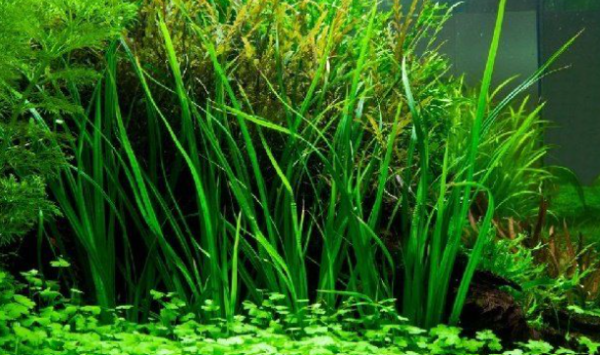
The plant may grow to a height of 40 cm, with leaves ranging from 5-7 mm in width. Because of its inadequate root structure, the plant cannot withstand strong water flow or attempts by large fish to drag it away from the substrate.
The ability of this plant to grow underwater makes it an excellent choice for use in outdoor pond landscaping and the more adventurous aquarium Aquascape designer.
Types Of Cyperus Helferi
Over 900 species of Cyperus (papyrus sedges) exist, including the African papyrus (Cyperus papyrus) and the well-known houseplant Cyperus alternifolius (Cyperus alternifolius).
Cyperus Helferi: Size
The typical Cyperus Helferi grows up to 14 inches on the lower end and 16 inches for larger specimens.
Planting Cyperus helferi
This plant comes in pots from aquarium plant farms and the transition process from the pot to the aquarium bed can be a bit tricky at start.
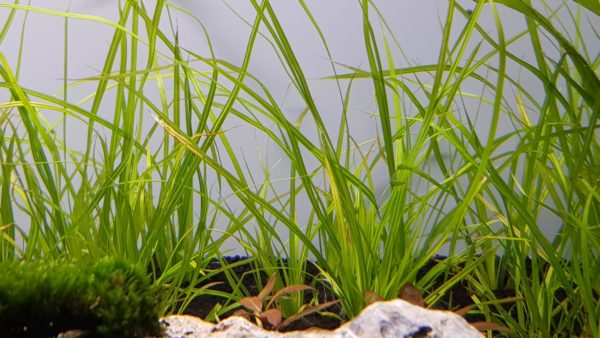
Some of the plants may not survive the process and those that do survive will recover in a couple of days given that they have the required conditions.
This plant will do best in larger tanks of 100 liters or more because the plant tends to spread its leaves around and can cover other plants if not trimmed correctly.
Even a single Cyperus helferi plant can bring a lot of distinction to a planted aquarium, we do not necessarily need to group more specimens of this aquatic plant in bushes, especially if we want a minimalist decoration in accordance with Japanese stamps.
Cyperus helferi can be sown both in the background, besides its aesthetic role with a pragmatic one, hiding various equipment necessary for the aquarium, as well as in the middle of the container. It is only the aquarist-gardener’s fantasy that decides the positioning of the Cyperus helferi, which will surely be a plant that will attract everyone’s admiration.
As a result of its propensity to “melt,” this plant may face some challenges when initially introduced to tank conditions. This is often the result of plant breeders growing plants in water to save money on production costs throughout the breeding process.
Transferring plants to an aquarium where they will be entirely immersed results in a transition period during which some leaves fall off or melt, depending on the species.
Propagation and maintenance
In small aquariums, it needs to be shortened regularly to fully enjoy this variety of dwarf plants, but in a medium or large capacity aquarium, as a rule, open to all peasant beauty .
There are multiple ways to propagate this aquatic plant. If left on its own, the mother plant will develop small adventitious plants at the base. Other ways involve taking trims of the top of the plant and planting them upside down in the substrate.
To ensure the survival of the small plants, we have to make sure that they have a developed root system that will allow them to survive when they are separated from the mother plant.
Cyperus Helferi: Care and Tank Set-Up
Cyperus Helferi: Tank Size and Specifications
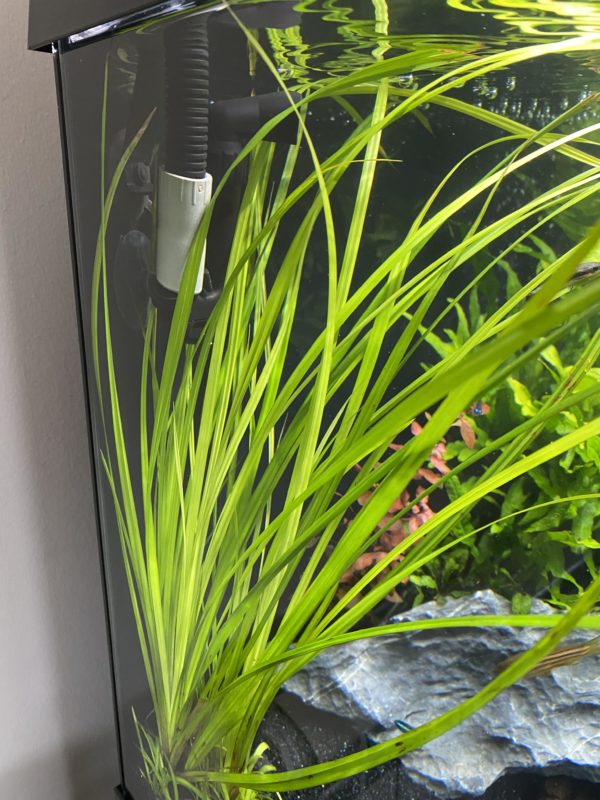
Because of the plant’s size, it thrives in larger tanks of 20 gallons or more. Because the optimal water temperature for the plant is between 22 and 28 degrees Celsius, the water in a tank should not be too hot. You should regulate the water’s acidity to a maximum of pH 7,2.
This plant is quite adaptive, and it may quickly be grown submerged or immersed in water. Even though it is a rosette plant, which is not recognized for having a solid root system in the first place, this plant’s root system grows to be quite powerful and thick.
It requires a lot of light to grow, and the addition of CO2 is advised to speed up the process. The plant sways beautifully in the water movement in aquariums with excellent water flow.
Maintain a moist but not flooded state of the soil. It is sometimes advantageous to include a “well” into your substrate to collect water, which can subsequently drain via a tube put into the well. It will be possible to prevent oversaturating your substrate due to this strategy.
Optimum Tank Size For Cyperus Helferi
The recommended tank size for Cyperus Helferi is 20 gallons.
Tank Shape For Cyperus Helferi
A large tank is required.
Filter Type
It can survive in tanks containing water purified by a reverse osmosis membrane.
Substrate
Because Cyperus Helferi pulls nutrients from the soil, you’ll want to use a substrate that has been created explicitly for planted aquariums while growing this plant. It is important to note that this species does not have a pervasive root system, especially when it is initially potted.
It is beneficial to the plant’s growth and development to grow it on a small-grained nutritive substrate rich in nitrates, phosphates, potassium, and other nutrients. It will be necessary to replenish the substrate with extra fertilizer if it lacks appropriate nutrients.
A fine-grained substrate is recommended to allow the roots to take root and stay securely in situ for an extended period. ADA Aqua Soil is a prevalent choice for planted aquariums in this business, and it is extensively used in many applications.
Water Parameters for Cyperus Helferi
Cyperus helferi can grow when sown in the aquarium substrate to a height of about 20-35 cm, the temperature at which it develops in good conditions is averaged between 20 and 30 °C. The hardness of aquarium water can fit in a wide range of values, between 1 and 20, and the pH accepted by the small aquatic plant is between 5 and 7.5.The plant particularly likes the soft, slightly acidic water of 25-27 °C and a strong light, similar to what is found in its native environment.
Cyperus helferi can grow even when it has a weaker, diffuse light, but if we provide at least 2-4 watts/gallon, it can grow spectacularly, especially if it has a sufficient amount of fertilizer and CO2. It needs nitrates, iron, potassium, but also microelements, so that its graceful leaves do not turn yellow and keep its own green greenery, which brings optimism to our soul and urges us to continually.
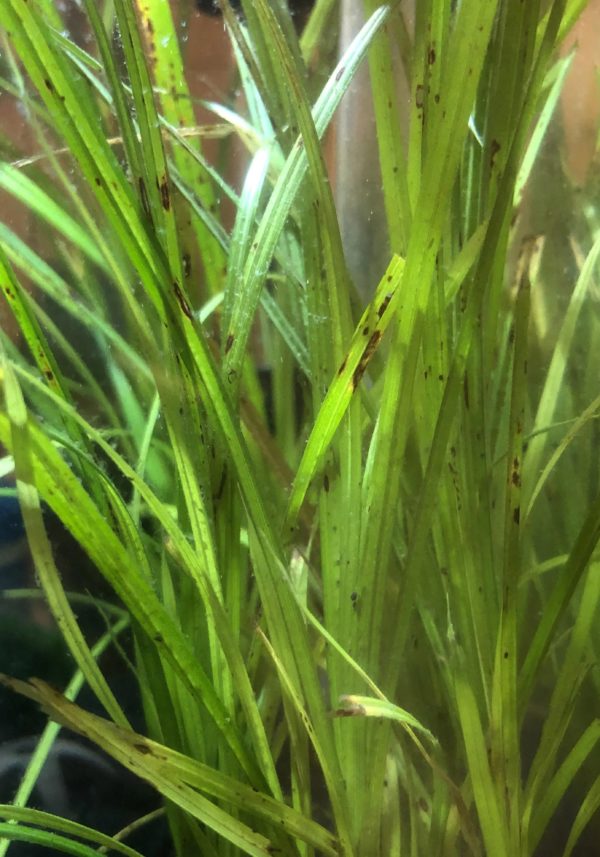
Water Temperature
The ideal water temperature for Cyperus Helferi is between 20 and 30 °C.
Water Flow Rate
The water flow in the aquarium must be low or moderate in order not to aggressively treat delicate plants and allow it to reverse their long, thin, arched leaves in the form of rosettes.
pH Level
The perfect water pH level for Cyperus Helferi is 5 and 7.5.
Water Hardness
1-20°dH
Cyperus Helferi Tank Landscape
The dry starting approach is a relatively recent technique that is gaining popularity. Cyperus Helferi, like other aquarium plants that can grow in water, may be grown from seed in a dry environment, similar to how other aquarium plants are grown. Start by laying down your substrate and hardscape materials, followed by placing your plants for a dry start.
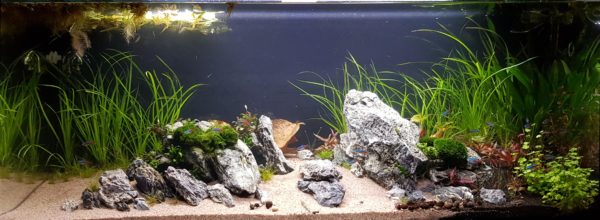
Cyperus helferi is often planted in the center of a tank, surrounded by shorter plants. It can also decorate the backside of small, planted tanks or create passageways beneath the water’s surface.
Worst Plants For Cyperus Helferi Tanks
- Acorus sp
- Pilea cadierei
- Chlorophytum sp
- Dracaena sp
- Marsilea sp
- Ophiopogon japonicus
- Spathiphyllum sp
- Alternanthera ficoidea
- Hemigraphis sp
Lighting For Cyperus Helferi Tanks
It is not difficult to keep Cyperus Helferi alive since it requires little care. This plant requires medium to high light levels to grow, requiring between 2 – 4 watts of light per gallon of water in the tank.
The best lighting for Cyperus Helferi is direct sunshine. Schedule 10 hours per day of light varying from moderately bright to dazzling. Add 180 LPG (lumens per gallon) to the soil for the best health and growth rate. Reduce this to 120 LPG if required, although you may encounter poor growth or other difficulties with your plants below that point.
Nutrient Requirements For Cyperus Helferi Tank?
The plant needs enriching nutrients such as NPK (Nitrogen, Phosphate, and Potassium) and supplementing micronutrients or trace minerals to grow.
Choosing a small-grained substrate rich in Kalium, Nitrates, and Phosphate is advised. Instead of them in the substrate, you’ll need to apply more advanced fertilization processes.
Cyperus Helferi: Compatibility
Using Cyperus Helferi in combination with other plants
There are numerous aquascapes that can use this plant, it is versatile and can be used in almost every combination. Here are a couple of aquascape plant combinations that include it:
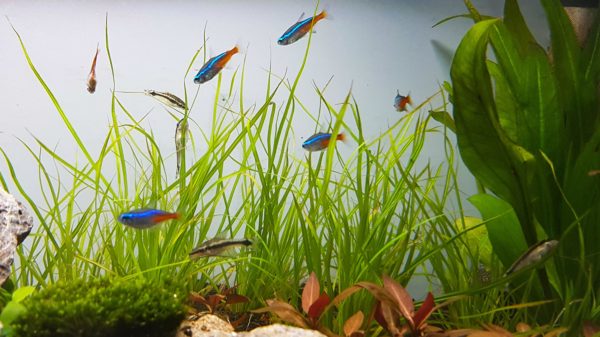
- Cyperus Helferi, Cryptocoryne Petchii, Eanunculus inundates, Eleocharis parvula, Pogostemon helferi, Anubias nana, Rotala Macrandra, Ludwigia glandulosa.
- Cyperus Helferi, Eriocaulon cinereum, Eleocharis acicularis, Elatine hydropiper, Helanthum Quadricostatus
- Cyperus Helferi, Rotala green, Hygrophila Araguaia, Anubias petite, Staurogyne repens, Pogostemon erectus, Bolbitis heudelotii, Microsorum pteropus
- Cyperus helferi, Limnophila hippuridoides, Rotala macrandra, Limnophila sessiliflora, Pogostemon erectus, Nymphaea lotus, Murdannia keisak, Crinum calamistratum, Bacopa caroliniana, Lobelia cardinalis
Cyperus helferi is considered to be one of the symbols of prosperity and rebirth, which can further enhance the role of a beneficial activator that an aquarium, well positioned according to Feng Shui rules.
Facts About Cyperus Helferi
- The leaves are also susceptible, which means that when they are immersed in water, they like to float gently on the water’s surface.
- As a result of the unusual growth of this plant, it is necessary to provide a sufficient amount of fertilizer in combination with Co2. Aside from these, it needs nitrate, potassium, microelements, and iron to work correctly.
- Due to its adventitious growth habit, the plants do not sprout from their roots but rather from the plant’s cut leaves and underground stems, which allows them to take advantage of the opportunity.
- In Thailand, it is claimed that the Cyperus Helferi was the first Cyperus species to be used in an aquarium, and this was the case. It may grow to be 20-35 cm tall and has a rosette 15-25 cm in width when fully grown.
- Cyperus helferi is a species of Cyperus native to the Asian continent, with the majority of its occurrences occurring in the country of Thailand.
- The development rate of this plant is also relatively slow, which means that it will take several months, if not a year, to reach its maximum height.
- Because of how the leaves of a fluffy bush are formed, the shape of a soft brush as it sways in the current is visually appealing.
- If necessary, they can be carefully relocated from their original place and transplanted to another area.
Are Cyperus Helferi Right for You?
If you want to add additional plants, maintain the number between 2 and 3 while keeping a simple concept. The plant may be reasonably trouble-free for the remainder of its life after being adapted to its new tank habitat. However, if it is put in the right spot and contrasted with other plants to make a balanced presentation, it may also exude its allure in a planted tank.
Because of its reputation as a plant that more experienced gardeners should only tackle, Cyperus Helferi is often avoided. This is due primarily to the problems it has adjusting to completely submerged growth circumstances in an aquarium setting.
FAQs
What Is The Cyperus Helferi Growth Rate?
Cyperus helferi is a tall grass-like plant that may be grown as an emergent plant or underwater. It has long, thin leaves that may grow 20 inches or more.
Is Cyperus A Water Plant Or A Land Plant?
Cyperus helferi is an aquatic grass that may grow in submerged and immersed environments. It has a bright green leaf suitable for use in any planted aquarium.
Is It Possible To Cut Cyperus Helferi Down To Size?
Cut the leaves off if they get out of proportion. You don’t want a jungle look in your tank since Cyperus helferi is best suited in a minimalist-themed aquascape.
Is Cultivating Cyperus Helferi Difficult?
Cyperus helferi may grow rather large, but you can keep it in control by cutting the older leaves.
Is It Necessary To Prune The Cyperus Helferi?
Because Cyperus helferi thrives in an aquascape with a minimalist theme, which is precisely what you want, you do not want to create a jungle-like environment in your tank. When you cut it with scissors, the cuts will stop developing and eventually rot and die in the usual run of events.
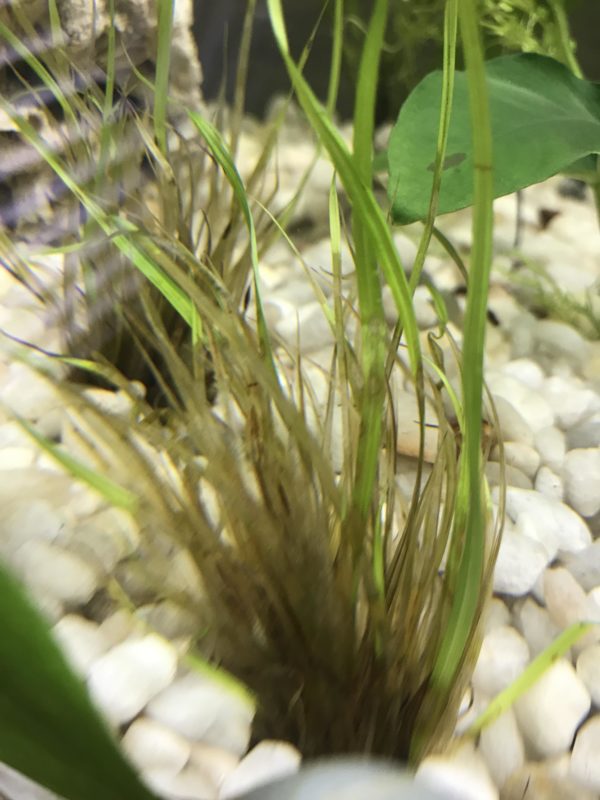
Is CO2 Necessary For The Growth Of Cyperus Helferi?
In Thailand, it is claimed that the Cyperus helferi was the first Cyperus species to be used in an aquarium, and this was the case. It may grow to be 20-35 cm tall and has a rosette 15-25 cm in width when fully grown. It requires a substantial amount of light to produce, and the addition of CO2 is recommended to expedite the process.
When It Comes To Spreading Cyperus Helferi, What Is The Best Method?
Plants in good condition will continue to grow on their rosulate base, and they may be cut off with a sharp pair of scissors and re-planted to propagate the plant.
Is It Challenging To Grow Cyperus Helferi In A Greenhouse?
Even though Cyperus helferi can grow to tremendous dimensions, it is not difficult to keep it under control by cutting the older outer leaves of the plant. It is possible to sustain the plants in a smaller tank for an extended time if purchased in a tissue culture package since they are relatively negligible.
Conclusion
The Cyperus genus has over 900 species, including the African papyrus and the well-known house plant Cyperus Alternifolius. Cyperus helferi is one of just a few Cyperus species that can live in water, and it’s also one of the hardest to grow. This aquatic plant may be submerged and emerging from stagnant or slow-moving water in Thailand.
No related posts.
